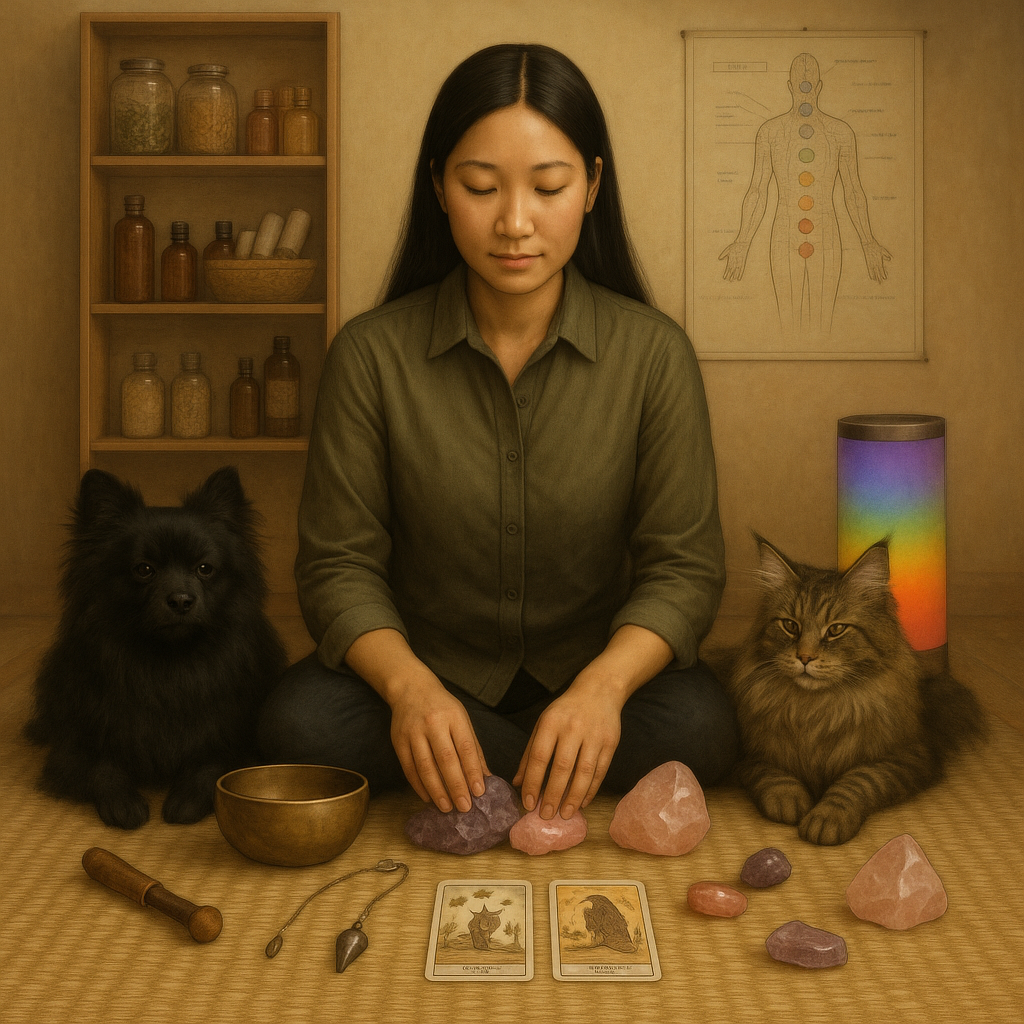
Energetic and holistic approaches applied to animals – a unified vision of care
Share
A single language for the living: Weaving links between energetic and holistic approaches for animals

There is no single way to listen to, understand, or support an animal. There are a multitude of complementary paths, often overlooked or perceived as alternatives, but which all have one thing in common: they are based on a holistic and vibrant vision of the living.
Today, animal kinesiology, intuitive communication, traditional medicines, and therapies using sounds, colors, plants, and stones are no longer reserved for those with a passion for spirituality. They are part of a new awareness of care: more respectful, more refined, and more connected.
These disciplines are not isolated. They are threads of the same weave, united by a common intention: to restore balance, not by imposing, but by listening. Here's how they come together, intertwine, and enrich one another.
Animal Kinesiology: Vibrational Listening Through the Body

Animal kinesiology uses energetic muscle testing as a means of accessing imbalances within the animal. It helps identify the source of stress—whether physical, emotional, environmental, or even karmic—and supports a process of overall rebalancing.
It's a bridge method because it provides access to subtle information while remaining anchored in a structured practice. It can also validate which other disciplines are indicated: a Bach flower? An elixir? A stone? A color? A sound session? Muscle testing then becomes a golden thread between practices, revealing what is right, here and now.
Animal Communication: The Intuitive Awareness of Connection

Intuitive animal communication offers direct access to the animal's soul, through feelings, images, words, or sensations perceived by the communicator. It provides access to what the animal is experiencing internally, beyond symptoms or visible behavior.
Often used before or in addition to a kinesiology session, it allows us to better understand the emotional or symbolic origin of a feeling of unease, and to honor the silent words of the animal. Together, kinesiology and communication open a space of fine, sensitive and aligned understanding.
Chromotherapy, lithotherapy, sound therapy: Treatment through frequencies

Every living being is made of frequencies. These three approaches work from specific vibrations to restore harmony.
Chromotherapy works through the light frequency of colors. Blue light soothes a tense nervous system. Red warms and grounds. Green restores balance. Used in the environment or on specific areas, it provides gentle support.
Lithotherapy uses crystals to diffuse natural vibrational information. Rose quartz for the heart, amethyst for soothing, tourmaline for protection, and tiger's eye for strengthening. These stones can be placed near the bed, used for direct healing, or worn within reach.
Sound therapy (tuning forks, singing bowls, sacred frequencies) acts directly on the subtle bodies. It is ideal for closing a kinesiology session, dispelling energy residue, or bringing the animal back into a state of vibrational unity.
These therapies blend naturally with kinesiology, which can test which frequency or support is most appropriate at a given time.
Animal Tarot: The Archetype as a Mirror of the Soul

Animal tarot is not a divinatory tool. It's a symbolic reading tool. Each card acts as an archetype, a mirror of a situation, an energy at play, or a human-animal bond.
Drawing a card for an animal can open up a new angle of understanding: "What is my animal the messenger of?" "What inner posture am I invited to adopt in the face of what it is going through?"
It is a meditative and revealing approach, which perfectly complements kinesiology by giving meaning to the corrections or messages received.
Animal Naturopathy: The Land as a Foundation

Naturopathy focuses on the animal's overall health: diet, lifestyle, digestion, elimination, immune system, and chronic stress. It is based on the principles of prevention, self-regulation, and balance.
It works in synergy with kinesiology, which can detect assimilation imbalances, deficiencies, or overloads, and validate which natural remedies (plants, cures, supplements) will be the most beneficial.
Naturopathy extends energetic care into everyday life, supporting the physical foundations necessary for the integration of change.
Ayurvedic Medicine & Traditional Chinese Medicine: The Founding Wisdoms

These two ancestral medicines provide a complete and coherent holistic vision of life:
Ayurveda, with its doshas (Vata, Pitta, Kapha), invites us to understand the animal's constitution, its rhythm, its strengths, and its imbalances. It offers powerful tools in herbal medicine, massage, and tailored nutrition.
Traditional Chinese Medicine (TCM) forms the basis of many kinesiology protocols. It allows us to understand energy flows through the meridians, to associate an emotion with an organ, and a behavior with an element.
They are wonderful reading grids, which enrich the practitioner's work, refine the analysis and allow for more personalized support that respects the specific nature of each animal.
Animal Dowsing: Vibrational Reading by Pendulum

The pendulum is a precise, neutral, and adaptable energy reading tool. It can be used remotely or in conjunction with muscle testing to validate a choice (elixir, dosage, remedy), detect energy pollution, or an emotional burden.
Dowsing is often used in sensitive or complex cases, when the animal is nearing the end of its life, too agitated, or too weakened. It offers a precise channel to refine treatment already underway.
Conclusion: A unified approach to animal care
These disciplines, far from competing with each other, complement and respond to each other .
Each acts at its own level: body, heart, energy, memory, intuition. Together, they form a complete language of life, capable of supporting the animal in its entirety.
Practicing with all these keys means recognizing that each being is unique, sensitive, and multidimensional. It also honors the bond between the animal and its guardian as a shared path of evolution.
What if, at heart, true care isn't a technique, but a closely connected act of listening?
